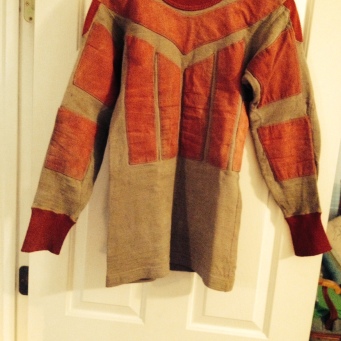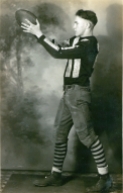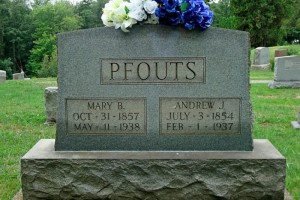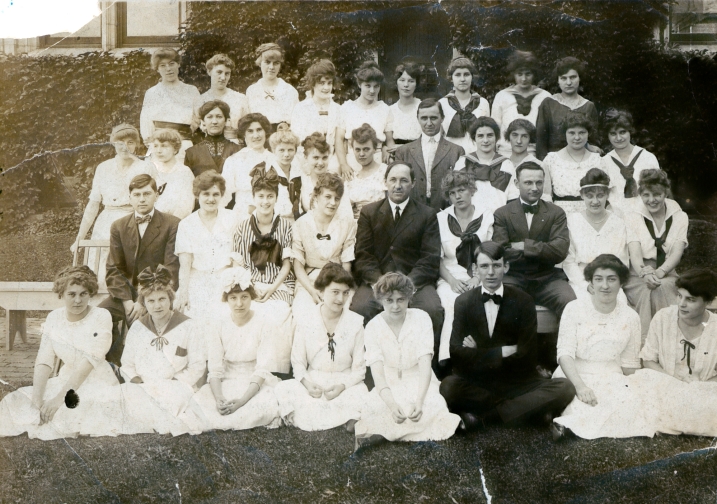
Colt’s grandfather, Don Foutz, set records as starting halfback for Dover in 1931 that would stand for more than six decades.
Recreating Grandpa Foutz’s Football Jersey
It was the doldrums of summer, 2014, and I found myself in a bit of a doldrums myself.
My company of 6 years, VivaKi, had just navigated a series of reorganizations, and on a fateful August morning I learned my task for the following two months: dismantling the 45-person Creative team I’d built since 2008 and saying farewell to my dozen-strong Paid Search team as well.
Oh yeah, and to VivaKi, too.
In the midst of that final transitional slog, I was determined to draw inspiration from whatever sources I could whip up. Among the sparks: throwing myself into a daily workout regimen, mining new business connections in Sioux Falls, soaking in all that summer — and pending severance — could offer, and, in a short list I’d made of dream projects I might get to before the new job kicked off, exploring the creation of a replica jersey to honor my grandfather, Don Foutz.
Grandpa had been a source of fascination for me for nearly my entire life. We lost him far too young, in 1980, at 66. My dad was 28 then. Having benefited form his patient and loving example for nearly 39 years now, I couldn’t imagine having that light cut short as a young man and new father. And having only vague memories of Grandpa Foutz, since I was only 4 years old when he passed away, I found myself seeking to know him, and his family origins, as I grew into a young man with a family of my own.
This blog is filled with the fruits of those efforts. We know about the Foutz (then Pfouts) family’s origins in Wuerttemberg, and patriarch Michael Pfoutz making the journey to America in 1787. We’ve traced our origins through Maryland, and then Harrison County, Ohio from 1810 to 1901, and then on to Dover, which has been home base for our family for four generations.
Getting to know grandpa has meant getting to know more about an essential tradition in my hometown. High school football has formed the core of autumn Fridays since Dover’s squad first suited up in the 1890s. And though I opted for cross country, marching band and track during my years at Dover High, I counted a brother, two uncles, my dad and, of course, grandpa, as familial connections to the gridiron, and have carried my diehard fandom for the Browns and Buckeyes as my own path has wound through Pennsylvania, Illinois and on to South Dakota.
That Dover’s traditions were my own made discovering grandpa’s exploits as star halfback for some of Dover’s first great teams all the more awesome. This blog has recorded those discoveries. Three brief examples: Pictures to commemorate Don Foutz’s 100th birthday, when for a time, I didn’t have any in my possession. A series in 2010 that recounted every game of the 1931 season, culminating in grandpa’s record 220 rushing yards against arch rival New Philadelphia, a mark that stood for 64 years. And, most recently, an examination of the principal players in the 1929 rivalry game, during which grandpa threw a game-losing (for Dover) interception to distant cousin Earl Foutz — though they never knew they were related.
For Christmas, 2011, I collected my blogs and scanned each page of grandpa’s football scrapbook, bound it up and presented the book to my father and three brothers. After moving far from home to Sioux Falls in 2012, I blew up some of the glorious game shots from 1931 of grandpa in action, framed them, and hung that history in our family room, site of many a Saturday spent sweating out Ohio State drives.
This has been my way of hanging on to family history and a sport that runs through our genes. That history makes the game far more enjoyable to me than if I was just following the box scores — a quaint term, there — of today with no memory of the storied past. You could say I’m a bit of an obsessive — opting for a hacked 2008 version of Madden for PC, even as breathtaking updates for game consoles receive annual release, so I can play the 1950 Browns, even the old Buckeyes, in uniforms and stadiums rendered in all their bootleg glory. And when it comes to showing my team colors, I’m more likely to opt for a Woody Hayes cap, or a commemorative 2002 OSU Championship T-shirt (not to mention a 1960 basketball championship tee), or a classic wool 1915 Augustana College cap (nod to my wife’s alma mater) than swathing myself in today’s polyester and mesh bandage material with the names of “stars” unlikely to stick around or attain any weight to their names.
When it comes to celebrating my love of football, and saluting my hometown and family that developed that love, I could think of no better — no cooler — way to embody that history than somehow recreating my grandpa’s 1931 Dover Crimsons jersey. And sharing that celebration with my family. But how?
Ebbets Field Flannels for the Win
Like a lot of kids, my admiration of sports uniforms — the designs, the colors, the functional cut — probably grew exponentially with the tens of thousands of football, baseball and basketball cards I collected. As a budding writer and history buff, the stats and bio snippets on the backs were equally engrossing.
Even as my bookshelves grew heavy with sports tomes and their giddy tales and even giddier glimpses at the past, nothing quite captivated me with its blend of stories, images and, as a knockout bonus, “gettable” apparel the way a certain catalog did in 1990.
That summer, my dad’s Sports Illustrated profiled a new company in Seattle that produced “vintage authentic” baseball jerseys from the old, old days. Ebbets Field Flannels took their name from founder Jerry Cohen’s hometown Brooklyn Dodgers, and paired a nose for research with a dogged commitment to authenticity to track down the old mills, the actual fabrics and the handmade processes that went into the flannel works of art of a bygone era.
That these replica jerseys and caps could be bought and worn ranked second in my fascination with the Ebbets catalog itself. I’d signed up virtually the moment I read the last word in the SI piece, and though the prices were out of reach for my 14-year-old self, I savored every page of the catalog when it arrived in the mail, poring over the old names, stadiums, leagues obscure and renowned, and pages and pages of unique, colorful apparel with history.
With a growing family and the usual list of expenses, I didn’t indulge in my Ebbets obsession beyond grabbing a Portland Lucky Beavers T-shirt in college, and snapping up that Woody’s Cap — a partnership with Homage — after moving to Sioux Falls. But this summer I took advantage of a rare $100 jersey sale and chose another team close to home, the Cleveland Buckeyes, 1945 champions of the Negro League. I was jubilant as a damn kid when the package arrived a couple days later. The outstanding, handmade quality and attention to historic detail made this instantly the favorite item in my closet.
So I had my eyes on Ebbets again when the company brought back a favorite I’d remembered from my teenage days devouring the catalog. Their hand-knit wool football jerseys set me dreaming about heading back to 1931 to produce a replica Dover Crimsons jersey.
But grandpa’s garb presented a unique challenge. “Friction strip” jerseys from the 1920s and ’30s are among the most sought after by collectors, with rare unearthed finds from teams of distinction selling for tens of thousands of dollars at auction, and examples of well-preserved uniforms from practically unknown teams still fetching hundreds and thousands.
There’s a reason why no one makes the jersey today. The canvas “friction strips” sewn into the chest and arms had long ago outlived their usefulness, dating back to when runners were only down by contact, and when the refs’ whistles blew, and the rough fabric helped players hold onto the ball. Despite the often gorgeous geometric designs in the era’s uniforms, all that material — yarn, wool, felt and hand-sewn canvas fabric — makes it an impractical, and expensive, jersey to produce.
If anyone could do it right, I figured it would be Ebbets. But their custom flannel page, itself an inspiration for jersey buffs dreaming up the perfect apparel, advertised only baseball duds. But with the release of football and hockey wear, I decided to take a chance.
I emailed them in early October, after first gut-checking my dream project with my brothers, who, to their credit, were all-in from the beginning. I got a quick, and respectful, response. But a “no” answer all the same. Or rather, a not yet. Ebbets was gearing up to roll out more football jerseys in the coming months, but had tied up their unique, era-authentic knitting machines through the early spring. Christmas was not going to be an option.
But then, a lightning bolt. A second email hit my inbox from Jerry Cohen — founder of Ebbets. Jerry offered to oversee the project if we could get a minimum wholesale order together and promised to do his best to hit our Christmas deadline. Wow!
Tracking Down a Family Gem
The dream project was now gaining footing. Instead of presenting only my dad with a replica of grandpa’s 1931 jersey, we quickly recruited cousins Whitney and Lauren, Justin and Ketter, to produce jerseys for uncles Bob and Don, and a few for ourselves as well. I had a feeling my 14-year-old self might even be impressed.
Even though we had to move quickly to get the work going for Christmas, the obsessive in me wanted to be sure to get the details right. And true to form, Ebbets wouldn’t have wanted it any other way.
Although I could supply dozens of pictures from all angles from my grandpa’s scrapbook and other historic accounts, and countless examples of Dover’s traditional crimson and gray, could we really be sure of the colors? A phone chat with Jerry revealed our contradictory opinions — through his long experience interpreting old black and white shots, he believed the main jersey fabric was probably gray, and the friction strips some shade of red, but thought the shoulder and cuff materials were likely darker, maybe even black. Knowing our rival New Philadelphia’s hated red and black shades, and the length of that rivalry stretching to 1896, I doubted it… but how could we be sure?
The question I needed to answer: had anyone seen a jersey from 1931 before? And what were its colors? I turned to some trusted hometown sources, and ended up being surprised beyond my wildest estimation.
At first, I came up empty. Denny Rubright, author of several books about Dover Crimsons/Tornadoes football history, thought he had once seen color pictures of legendary Doc Kelker, a 1931 teammate of grandpa, in uniform, but thought they may have been colorized after the fact. My old classmate Matt Lautzenheiser, historian and author of two books on Dover history, including on the Dover-Phila rivalry — and, coincidentally, the player who first broke grandpa’s 64-year-old single-game rushing record, in 1995 — had captured the stories from players on both sides, but details like uniform colors were lost to memory.
Newspaper accounts from that season mentioned the uniform only once, in the several-story followup to the big game against Phila. Apparently, that Thanksgiving day Dover had donned, for the first time, a special all-white getup, from painted leather helmet down to pants and shoes. This uniform wasn’t in evidence at all in any of the pictures from grandpa’s 1929-31 seasons — though it probably is the uniform depicted in coverage of Kelker’s great undefeated teams of 1932 and 1933, which makes sense, given that the uniform likely debuted in the 1931 finale.
I even checked in with classmate, now principal, Karie McIlvaine McDade, whose own family history in Dover is rich, in the hopes somehow, somewhere, a uniform had been on display or at least seen. No dice.
Finally, I followed up on a rumor I’d heard a few years back, that someone in town had closeted away a jersey from that 1931 season. Like most folks back home, the connections were deep with former superintendent Emmet Riley. He’s been a Mason for 75 years, like my late grandfather Dr. Robert Earl Ley Jr. and ancestors before him. He was superintendent while three Foutz uncles, one Ley uncle and four Ley aunts were at Dover High School. And, following a career that included stints coaching Strasburg basketball, he substitute-taught for my mom, Janet Ley, in Garaway and Dover city schools.
It was a delight talking to the 97-year-old Riley from his retirement home in Dover. And, to his recollection, the jersey had been tried and true red and gray, certainly not black. He remembered “having a jersey like that once,” and said he would try to track it down. I thought, well, good enough. That was likely the closest I’d get. Though, like Matt Lautzenheiser, as an author I’d come to view the fuzziness of memory — learned firsthand as a newspaper journalist and while researching my book on 60 years of the Cavaliers Drum & Bugle Corps — with a jaundiced eye.
I decided to pursue one more angle. I phoned the Dover Public Library to ask for some research legwork on any possible mention in the newspapers of 1929-31 of Dover’s uniform manufacture or colors. My next call would have been to the Reeves Home & Museum to see if they — longshot — might have a uniform in their holdings or on display. But I was lucky enough to chat with director Jim Gill.
Gill, in another (now common) coincidence, had been a roommate at Ohio State of my classmate Nate Aames, whom I’d just reconnected with at our 20th high school reunion in September. Gill knew Emmet’s son, Eric Riley, quite well, and volunteered to check with Eric to see if rumors of his father having a 1931 Dover jersey were true. Barring that, Gill would put the library’s research team to the task of scouring old papers.
They never got the chance.
To my indescribable awe, Gill phoned me back within a day or so and let me know that, yes, Eric thought he had come across an old Dover jersey while packing up his parents’ home. And in fact, he remembered intending to give that jersey to the Foutz family after conversations years ago. Why was that? Because the jersey was thought to be the actual jersey my grandpa Don Foutz wore in the 1930-31 seasons.
After some emails back and forth verifying the look of the jersey, and a couple phone calls comparing hometown bonafides — turns out, Eric had graduated with my Uncle Bob, and knew my uncle Don and dad, Fred, for years and years — Jim sent a goosebump-inducing picture of the jersey. There it was — grandpa’s #6 on the back and Emmet’s memory vindicated — though the friction strips had faded to pink, the jersey was undoubtedly the historic red and gray, through and through. Eric agreed to mail me the jersey in order that a new plan might take shape — to surprise my dad with his father’s actual gameworn jersey when we gathered in Nashville for Thanksgiving, with the replica to follow for Christmas.
History You Can Hold — Smiles, Memories, Tears
Ebbets, by now, had started knitting the jersey. Jerry indulged a couple questions from me, and set me to the enlightening task of measuring the jersey for their reference. (I wasn’t about to send it to Seattle, even though that made sense, with the big reveal scheduled for Thanksgiving.) I grew to admire even more the everyday craftsmanship back then.
I haven’t yet discovered who made the jersey — and part of me wants to imagine mothers cutting and sewing each friction strip to a stock long-sleeved sweater of the day — but the geometry, the dimensions, the design: Dad has called it a “superman suit,” and I agree, our imaginations fired, no doubt, by images of the old “Crimson Flash,” as grandpa was called that magical 1931 season, darting around end and bulling in for a touchdown.
We all decided to wait until all sons – Colt, Dan, Jake and Sam – were present after the Thanksgiving meal to sit Dad down and lay the whole ton of bricks on him. We honestly didn’t know how he’d respond. Puzzlement. Joy. Tears. I wrapped it up in tissue paper and sealed it in a designer clothes box, and rehearsed my spiel.
It had been such a story to this point, I didn’t have to do more than just note what we’d all done to make this quirky dream a reality. A bit of odd timing: the Dover football Twitter page, on Thanksgiving day, posted a throwback tweet on the 1931 Dover-Phila game with a pic from my grandpa’s scrapbook. I chuckled and traded quips with them, looking forward to sharing this whole story after it had played out.
I don’t know if Dad expected to open up a replica jersey, a placeholder coupon, or what. But his face changed, unhinged really, when he put his hands on grandpa’s actual jersey and held it up for examination. “He was kind of a little dude back then, wasn’t he?” Dad asked, gauging the long-sleeved medium or large grandpa’s then-superman frame would carry today. Tears came then. And smiles. And hugs.
Christmas was almost an anticlimax. But there were still goosebump shivers ahead. The Friday before Christmas, a call came through from Seattle. Ebbets!
They were confirming shipping addresses and I couldn’t help asking, “is it done? Can I see pictures?”
Jerry emailed his account of “one of the most challenging sewing projects we have ever undertaken”:
Because the original jersey is a different size than these, we had to make some compromises in the placement of the friction strips between the photos you sent, your measurements, and the actual dimensions on the jerseys. This is so that when it was finished it lined up proportionally as close to the original as possible. It all had to work together like a puzzle. The top “V” had to come down a little lower than in the picture so that the strips below it and to the sides could line up proportionally. If we had brought the “V” up higher, the vertical strips below and the ones on the sides would not have had the proper relative dimensions.
To our misty eyes, and to our hearts and bodies as we donned the jerseys the first time, the work was a masterpiece, and one we can all be proud of. The family spent Christmas trading selfies with each other. And I don’t know about my brothers and uncles and cousins, but I now have a new favorite in my closet. And feel closer than ever to my grandfather every time I put the “superman” Dover Crimsons suit on.











































